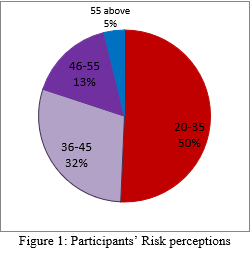Assessment of occupational health and safety risks in selected construction sites in oyo state, Nigeria
Keywords:
Occupational health, Safety risks, Construction, Personal Protective Equipment, Occupational health and safetyAbstract
Construction sites are an important part of the economy in many countries including Nigeria and is often seen as a tool for economic growth. However, these sites face significant occupational health and safety (OHS) challenges, characterized by high accident rates and substantial health risks. This study assessed occupational health and safety practices in selected construction sites in Oyo State, Nigeria, focusing on Reynolds Construction Company and Arab Contractors as case studies. Through a mixed-method approach involving interviews, questionnaires, and site observations, the research investigated current OHS assessment practices, risk management protocols, and implementation challenges. The study revealed critical findings: risk management responsibilities are exclusively delegated to contractors and limited to the construction phase, with no systematic assessment methodology in place. Instead, risk evaluation relies heavily on individual judgment, guided by personal experience, educational background, and existing regulations. The research identified that risk communication primarily occurs through toolbox meetings and informal discussions, while risk control predominantly depends on Personal Protective Equipment (PPE). Key factors influencing OHS management include regulatory frameworks, individual competencies, and work environment conditions. Notable challenges hampering effective OHS implementation include site configuration, procurement systems, design complexity, and geographical location constraints. Analysis of hazard consequences revealed that working at heights and manual handling presented the highest risk factors, followed by exposure to chemicals, dust, and noise. The study also found that 71% of workers lacked formal health and safety training, potentially contributing to the 31.74% rate of major accidents reported during task performance. This research recommends a more integrated approach to OHS management, emphasizing the need for active involvement from key project stakeholders, including clients, design teams, consultants, and government agencies, to enhance safety standards in Nigerian construction sites. The findings contribute to the understanding of OHS practices in developing countries and provide a framework for improving construction site safety in Nigeria. Therefore, in Nigeria, the study suggests that there is a need for the key project stakeholders such as client, design team consultants and government to be involved in managing health and safety risk on construction sites.
Downloads
References
P. Hughes and E. Ferrett, Introduction to health and safety in construction: The handbook for NEBOSH construction certificates, 4th ed. Routledge, 2011.
D. T. Giang and S. P. Low, "Role of construction in economic development: Review of key concepts in the past 40 years," Habitat International, vol. 35, pp. 118-125, 2010.
G. Carter and S. D. Smith, "Safety hazard identification on construction project," Journal of Construction Engineering Management, vol. 132, no. 2, pp. 197-212, 2006.
Y. Jung, S. Kang, Y. S. Kim, and C. Park, "Assessment of safety performance information systems for general contractors," Journal of Safety Science, vol. 46, no. 4, pp. 661-674, 2008.
H. Lingard and S. M. Rowlinson, Occupational health and safety in construction project management. Taylor and Francis, 2005.
Health and Safety Executive (HSE), Improving health and safety in the construction industry. The Stationery Office, 2004.
P. Argent and J. Forman, The power of corporate communication: Crafting the voice and image of your business. McGraw-Hill, 2002.
S. Baradan and M. A. Usman, "Comparative injury and fatality risk analysis of building trades," Journal of Construction Engineering and Management, vol. 132, no. 5, pp. 533-539, 2006.
M. R. Hallowell and J. A. Gambatese, "Construction safety risk mitigation," Journal of Construction Engineering and Management, vol. 136, no. 9, pp. 139, 2010.
I. W. Fung, V. W. Tam, T. Lo, and L. Lu, "Developing a risk assessment model for construction safety," International Journal of Project Management, vol. 28, pp. 593-600, 2010.
O. N. Aneziris, I. A. Papazoglou, and D. Kallianiotis, "Occupational risk of tunneling construction," Journal of Safety Science, vol. 48, pp. 964-972, 2010.
W. Wu, A. F. Gibb, and Q. Li, "Accident precursors and near misses on construction sites: An investigative tool to derive information from accident databases," Journal of Safety Science, vol. 48, no. 7, pp. 845-858, 2010.
C. T. Badenhorst, "Occupational health risk assessment: Central to the management of occupational health," in International Platinum Conference 'Platinum Adding Value', The South African Institute of Mining and Metallurgy, 2004.
A. R. Rwamamara, "Planning the healthy construction workplace through risk assessment and design methods," Ph.D. dissertation, Lulea University of Technology, Department of Civil, Mining and Environmental Engineering, 2007.
G. Kikwasi, "Client involvement in construction safety and health," Journal for Building and Land Development, Ardhi University, 2010.
A. P. C. Chan, F. K. W. Wong, D. W. M. Chan, M. C. H. Yam, A. W. K. Kwok, E. W. M. Lam, and E. Cheung, "Work at height fatalities in the repair, maintenance, alteration, and addition works," Journal of Construction Engineering and Management, vol. 134, pp. 527-515, 2006.
A. Rahim, A. Hamid, M. Zaimi, A. Majid, and B. Singh, "Causes of accidents at construction sites," Malaysian Journal of Civil Engineering, vol. 20, no. 2, pp. 242-259, 2008.

Downloads
Published
How to Cite
Issue
Section
License
Copyright (c) 2025 Funminiyi Oyekunle, Sanya OGUNSUSI, E.O. Aiyewalehinmi, Kunle AMOKO

This work is licensed under a Creative Commons Attribution 4.0 International License.
Copyright on any article in the International Journal of Engineering and Applied Physics is retained by the author(s) under the Creative Commons license, which permits unrestricted use, distribution, and reproduction provided the original work is properly cited.
License agreement
Authors grant IJEAP a license to publish the article and identify IJEAP as the original publisher.
Authors also grant any third party the right to use, distribute and reproduce the article in any medium, provided the original work is properly cited.
Most read articles by the same author(s)
- Funminiyi Oyekunle, Prof. B. D. Oluyemi-Ayibiowu, Adeola Akinsuyi, Optimization of concrete produced from industrial waste and fibre using regresion model , International Journal of Engineering and Applied Physics: Vol. 4 No. 3: September 2024
- IJANUSI Ebenezer Oluwafemi, AIYEWALEHINMI E. O., Funminiyi Oyekunle, ODOFIN Sunday Festus, Evaluation of production cost of bricks using clay and stone dust-cement , International Journal of Engineering and Applied Physics: Vol. 5 No. 2: May 2025














